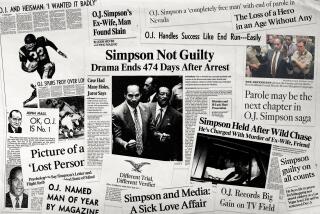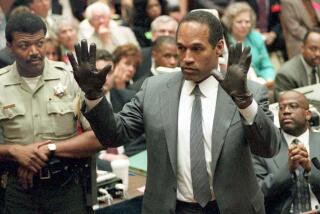Remembering Joe McGinniss

- Share via
Joe McGinniss, who died Monday from complications of prostate cancer at age 71, liked to break the rules. His best known book, 1983’s “Fatal Vision,” provoked a controversy over the author’s methods; it was McGinniss to whom Janet Malcolm was referring in her famous opening to “The Journalist and the Murderer,” which critiques his relationship with “Fatal Vision’s” subject, former Green Beret doctor Jeffrey MacDonald, who was convicted of murdering his wife and family in 1970.
“Every journalist,” Malcolm wrote, “who is not too stupid or too full of himself to notice what is going on knows that what he does is morally indefensible. He is a kind of confidence man, preying on people’s vanity, ignorance, or loneliness, gaining their trust and betraying them without remorse.”
That this is true goes without saying, and yet, McGinniss was anything but stupid, even if he could be full of himself. Why not? His first book, “The Selling of the President 1968,” published when he was just 26, helped to reinvent the art of political writing, looking at the presidential campaign of Richard Nixon not through the lens of policy but rather of mass media.
If, 45 years later, that hardly seems remarkable, it is in no small measure due to what McGinniss achieved. In that sense, “The Selling of the President” is a groundbreaking piece of journalism, a report from inside the sausage factory, where we see how Nixon’s image — and his election — was secured.
To write “The Selling of the President,” McGinniss negotiated something close to total access; he was in strategy sessions, TV studios, everywhere his subjects were. It’s the sort of exposure we couldn’t imagine a political candidate giving a reporter now, and yet, it suggests something of the author’s tenacity.
In the case of “Fatal Vision,” the dynamic was more complicated; as McGinniss acknowledged in the epilogue to a 1989 edition of the book, he and MacDonald “signed an agreement that specified that in return for granting me ‘exclusive story rights’ to his life, MacDonald would receive 20 percent of the first $150,000 paid to me by any publisher for a book about him and 33 percent of any proceeds beyond that. In addition, the agreement stated that MacDonald would receive 40 percent of any motion picture or television proceeds.”
Whatever we think of such an arrangement, it indicates the extent to which McGinniss was willing to go to get the story.
“Most good journalists who hope to get inside someone else’s world and stay there awhile come on very softly and do not bombard their subjects with questions,” Tom Wolfe wrote in 1973, in a passage quoted approvingly by McGinniss, “… Your main problem as a reporter is, simply, managing to stay with whomever you are writing about long enough for the scenes to take place before your own eyes.”
For McGinniss, this meant sharing living space with MacDonald and his legal team; he even sat at the defense table during the trial. When his book appeared, with its thesis that MacDonald had killed his family in a fit of drug-induced psychosis, his subject felt betrayed.
There was a lawsuit and a hung jury, and eventually, a monetary settlement. Through it all, McGinniss maintained he was doing his job.
“If you are going to be a nonfiction writer,” he observed at the end of that 1989 epilogue, “you must be willing to go where the story leads you even if it isn’t where you want to be. And, as the occasion demands, you must be willing to publish unpleasant truths — rather than pleasant untruths.”
This, I think, is the point precisely, and the source of McGinniss’ legacy. Journalists, writers, are supposed to stir it up, to tell the stories they encounter, rather than those we wish for them to see.
“Comfort the afflicted and afflict the comfortable,” H.L. Mencken is reported to have said about the fundamental purpose of journalism, and it’s an ethos that applies to McGinniss’ work. For his final book, “The Rogue: Searching for the Real Sarah Palin,” he spent 3½ months living next door to the former Republican vice presidential candidate’s compound in Wasilla, Alaska, a decision that generated another set of controversies.
“The Rogue” was not a great book; it relied on too many unnamed sources, and it wore the author’s anti-Palin sentiments on its sleeve. At the same time, it was consistent, in its way, with the arc of McGinniss’ career.
Over the span of nearly half a century, throughout a dozen books, he wrote about the intersection of public and private narrative, from murder trials to political campaigns. He got his hands dirty; he got in the mix.
“To me,” McGinniss wrote, “the problem of the reporter and the subject seems analogous to that posed by Heisenberg in his formulation of the ‘uncertainty principle,’ which states that any attempt to measure precisely the velocity of a subatomic particle will knock it about in an unpredictable way, thereby altering the very force that the experimenter has sought to quantify. The reporter, by his very presence, causes a change in the behavior of the person about whom he eventually hopes to write. His goal should be to minimize this alteration.”
He’s right, of course, about both the effect and the uncertainty, but what he’s really offering is a code not just for journalists but for every writer: to have no greater loyalty than to the story itself.
ALSO:
‘Fatal Vision’ author Joe McGinniss has died at 71
Joe McGinniss’ ‘Selling of the President 1968’: A look back
Joe McGinniss dies at 71; journalist-author wrote ‘Fatal Vision’
More to Read
Sign up for our Book Club newsletter
Get the latest news, events and more from the Los Angeles Times Book Club, and help us get L.A. reading and talking.
You may occasionally receive promotional content from the Los Angeles Times.








